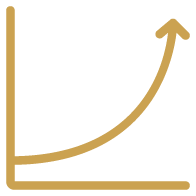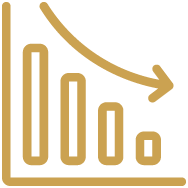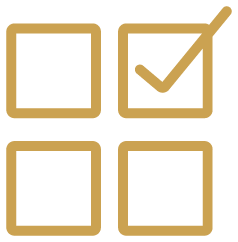-
What is a VA Loan?
Used by over 20 million Veterans, these home loans offering zero-down-payment options were established in 1944 to help servicemembers returning from WWII re-enter civilian life. Made by approved lenders, VA mortgages have unique advantages over other kinds of loans.
Quick Facts About the VA Home Loan Program
VA loans have a unique combination of features not found with other loan programs. Because a portion of each loan is guaranteed by the VA for the lenders, they can offer more favorable terms, such as:
- No down payment potential
- No PMI (VA Funding Fee for program use unless exempt)
- Competitive interest rates
- Streamlined refinancing program
- Limits on allowed fees
Home Loan Benefits for Every Stage of Life
Whether you’re buying your first home, needing more space for your growing family, or downsizing as an empty nester, the VA homebuying benefit can be used over and over. It’s possible to restore entitlement from a prior loan and use it again, making VA loans a benefit for life.
Is a VA Loan the Best Option?
There’s a reason why more than 740,000 Veterans and their families chose to use their VA loan benefits in 2017 alone. The benefits – zero down payment, no PMI, and, interest rates that are competitive with other major loan programs – can leave more money in your bank account and save you thousands of dollars over the life of your loan. Combined with the VA’s safeguards in the program that can help protect borrowers, the VA loan benefit is often the preferred option for eligible Veterans.
-
Am I Eligible?
If you are a Veteran, active duty servicemember, surviving spouse, reservist or national guardsman, academy cadet or midshipman, an officer of the National Oceanic and Atmospheric Administration (NOAA) or U.S. Public Health Service (USPHS), or if you are a WWII merchant seaman, you may be eligible.
You may be eligible for VA home loan benefits if you're a(n)...US military VeteranActive duty service-memberSurviving spouseReservist or national guardsmanAcademy cadet or midshipmanNOAA officerUSPHS officerVA Home Loan Benefits Depend on When You Served
You may meet the minimum VA eligibility requirements if you served as few as 90 total days of active duty. However, varying service requirements exist for different periods of war and peace. This chart can help you understand your VA loan eligibility:
WWII Veterans- Service:
September 16, 1940 - July 25, 1947- Requirement:
Minimum 90 days active dutyPost-WWII Veterans- Service:
July 26, 1947 - June 26, 1950- Requirement:
Minimum 181 continuous days active dutyKorean War Veterans- Service:
June 27, 1950 - January 31, 1955- Requirement:
Minimum 90 days active dutyPost-Korean War Veterans- Service:
February 1, 1955 - August 4, 1964- Requirement:
Minimum 181 continuous days active dutyVietnam War Veterans- Service:
August 5, 1964 - May 7, 1975(If you served in the Republic of Vietnam, start date is February 28, 1961)- Requirement:
Minimum 90 days totalPost-Vietnam War Veterans- Service:
May 8, 1975 - September 7, 1980(Officers start date is October 17, 1981)- Requirement:
Minimum 24 continuous months OR The full period (at least 181 days) called or ordered to active duty24-Month Rule- Service:
September 8, 1980 - August 1, 1990(Officers start date is October 17, 1981)- Requirement:
Minimum 24 continuous months OR The full period (at least 181 days) called or ordered to active dutyGulf War Veterans- Service:
August 2, 1990 - present- Requirement:
Minimum 24 continuous months OR The full period (at least 90 days) called or ordered to active dutyCurrent Active Duty (Anywhere)- Service:
Anytime- Requirement:
Minimum 90 continuous daysGulf War National Guard and Reserve- Service:
August 2, 1990 - present- Requirement:
Minimum 90 days active serviceFor more information, read The Ten Facts About VA Loan Eligibility
Six-Year Rule for National Guard and Reserve Members
You may be eligible for a VA home loan if you’ve served six years selected reserve or national guard, and any of the following is true:
- You were discharged honorably.
- You retired.
- You were transferred to standby reserve or ready reserve.
- You are still serving in selected reserve.
Surviving Spouses May Be Eligible for VA Loans
If you are a surviving spouse, you may be eligible if you meet the following criteria:
- You have not remarried (or have remarried after age 57 on or after 12/16/2003 and have applied for eligibility by 12/15/2004).
- Your spouse died in service or from a service-related disability, OR is missing in action or a prisoner of war.
- Your spouse was totally disabled for a certain amount of time (10 years prior to death or not less than five years from date of discharge or release from active duty to date of death) and was eligible for compensation at death.
VA Loan Eligibility Self-Assessment
Still not sure if you qualify for a VA loan? Only the VA can confirm your eligibility, but we offer a VA Loan Eligibility Self-Assessment that can help discern whether you meet the basic requirements.
Proof of your eligibility for your VA loan is given by a Certificate of Eligibility (COE).
Certificate of Eligibility
Your VA mortgage application will require a Certificate of Eligibility (COE).
The document can be obtained in three different ways.Request by Phone
Fast Processing
OrRequest Online
Moderate Processing
OrRequest by Mail
Slowest Processing
1-on-1 Assistance
Self Service
Self Service
Best For:Those who are actively serving or have a DD-214
Best For:Separated servicemembers who do not have a DD-214
Best For:Surviving spouses of servicemembers
Request by Phone
Fast Processing
1-on-1 Assistance
Best For:Those who are actively serving or have a DD-214
OrRequest Online
Moderate Processing
Self Service
Best For:Separated servicemembers who do not have their DD-214
OrRequest by Mail
Slowest Processing
Self Service
Best For:Survivng spouses of servicemembers
-
Do I Qualify for a VA Home Loan?
Qualifying for a VA loan can be a fairly straightforward process. Since VA loans are made by VA-approved lenders, you must meet credit guidelines, have sufficient income, and obtain a valid COE from the VA. While the VA has minimum qualifying guidelines, individual lenders generally have additional requirements for their borrowers.
Quick Facts About VA Loans
Quick Facts About the VA Home Loan Program
Good
credit
score
A credit score that meets lender’s guidelines, typically in the mid 600s

Lower
DTI
ratio
A debt-to-income (DTI) ratio of 41% or lower (certain exceptions apply)

Adequate
residual
income
Residual income within the standard for your region and family size

Steady,
long-term
income
At least two years of steady and documented income

Reliable
credit
card use
Resolution of any major credit issues or a track record of responsible use

Four Keys to Approval
When a Veteran applies for a VA loan, the lender considers at least four important elements:
- VA entitlement: Do you have ample entitlement to back the loan?
- Eligible property: Does the property you’re financing meet the VA’s minimum property requirements (MPRs)?
- Occupancy: Will you live in the home as your primary residence?
- Financials: Do you have qualifying income, credit, and assets?
Credit and Income Requirements
What do VA lenders look for? (Exceptions apply.)
- Qualifying credit score: A credit score that meets your lender’s guidelines. At Veterans First, the minimum credit score is typically in the mid 600s.
- Workable DTI ratio: A debt-to-income (DTI) ratio low enough to pass underwriting standards.
- Adequate residual income: Residual income within the standard for your region and family size.
- Steady, long-term income: Proof of a consistent income source, generally two years’ worth.
- Reliable credit history: Resolution of any major credit issues or a track record of responsible use.
What If I Don’t Qualify Right Away?
If you don’t qualify immediately, don’t be discouraged. Often, it’s a matter of improving your credit and demonstrating that you’re in a position to make mortgage payments on time. Many hopeful borrowers find that they need to work on their credit first before qualifying for a VA home loan. And generally, borrowers whose credit does not qualify at first can take a few simple steps to improve their credit. Those who overcome credit hurdles often find it to be a rewarding and educational process.
How Much Can I Borrow?
The VA puts no caps on how much an eligible Veteran with full entitlement can borrow. Your maximum possible VA loan amount depends on your qualifications and your financial means. A Veteran with ample entitlement, income, assets, and credit may quality for a zero-down VA loan of even $1,000,000 or more.
VA loans with no down payment can be offered to qualified borrowers who have either full or partial entitlement. If some of your entitlement is tied up with a prior VA loan, and won’t be restored, the VA limits the amount of a zero-down loan to four times your amount of available entitlement. A loan amount exceeding that will require a down payment.
-
The Five Steps of the VA Loan Process
There are five main steps in the VA home loan process: research, prequalification, house hunting, processing and approval, and closing and moving in. Learn more about these steps below.
Research
Research homes in your desired neighborhoods to get an idea of what kind of home you might like to own. Also, begin reaching out to lenders. This can give you a good feel for what kind of services and loan products are available to you.

Prequalification
Sellers (and their real estate agents) typically prefer a “prequal letter” to accompany serious offers. A VA-approved mortgage lender, not the VA, provides the letter. To prequalify, tell your lender all about your credit, income and assets. Keep in mind that you’ll be documenting everything later. If you prequalify, you will get a letter stating that you’ve prequalified to purchase a home, within a ballpark price, pending final loan approval.

House Hunting
Shopping for your dream home is exciting, but may require some patience. Make a list of features you want and need in your home. Many of our clients have found it helpful to work with a real estate agent who is familiar with VA loans. Once you find your home and make an offer, you’ll want to get the purchase agreement to your lender right away.

Process and Approval
As your loan is processed, an appraisal will be done on the property. You will be asked to provide various financial documents to your lender, including tax returns, pay stubs, and bank statements. Other information, such as a divorce decree for example, may also need to be submitted. Documents like these are needed to complete your file so you can be eligible for final approval.

Closing and Moving In
Once your loan is ready, you’ll attend your closing and sign your loan documents. Nothing beats receiving your new keys and opening the door to a home that’s now yours!

-
VA Loan Rates and Fees
VA home loans have competitive rates when compared to other programs, and the VA’s program puts restrictions on lenders when it comes to the fees that can be charged.
How Do VA Home Loan Rates and Fees Compare to Conventional Loans?
VA loan rates tend to be competitive when compared to rates for conventional mortgages. In fact, it’s not uncommon for Veteran borrowers to get better interest rates on VA home loans than they are offered for other loan programs.
VA loans are also attractive to borrowers because the VA home loan program forbids lenders from charging certain fees.
VA Home Loan FeesAcceptable vs. ForbiddenOrigination fee of up to 1%Tax service feesVA funding fee (unless exempt)Seller or lender attorney feesReasonable interest rate discount pointsDocument preparation feesCredit report feeCommitment or marketing feesVA appraisal feeReal estate commissionsPrepaid fee for escrow, e.g., taxes, insurance, etc.Underwriting and processing feesAny other closing costs, e.g., title insurance costs, recording fees, etc.Prepayment penalties*A complete list of fees can be found in VA Pamphlet 26-7, Chapter 8.VA Mortgage Borrowers Don’t Pay PMI
VA borrowers don’t have to pay private mortgage insurance (PMI) each month. PMI is a monthly payment typically required on conventional loans when a borrower puts down less than 20 percent. Not having to pay PMI can save you $30 to $70 monthly for every $100,000 of the loan amount, making it one of the favorite features of VA loans.
VA Funding Fee
The VA Funding Fee is a one-time fee paid to the VA to cover administrative costs of the VA home loan program. Borrowers can pay it up front, or roll it into their loan. Some surviving spouses, certain disabled Veterans, and Purple Heart recipients on active duty are exempt from the fee. However, most borrowers are required to pay a VA Funding Fee.
VA Funding Fees for Purchase Loans
April 7, 2023 - November 15, 203110% or more down:1.25%Fee for repeat use1.25%Fee for first-time use5% - 9.99% down:1.50%Fee for repeat use1.50%Fee for first-time use0% down:3.30%Fee for repeat use2.15%Fee for first-time use -
VA Loan Limits No Longer Apply With Full Entitlement
The U.S. government sets mortgage amount guidelines, referred to as conforming loan limits, that help classify loans. In certain situations, the VA uses these limits to calculate how large a VA loan can be. But the limits only apply to those borrowers who don’t have full entitlement.
No Down Payment With Full Entitlement
If you do have full entitlement, or full entitlement will be restored for this loan, no loan limit applies. Your loan amount and zero-down potential are limited only by the amount a lender is willing to lend to you under the VA program – an amount that is impacted primarily by your credit and ability to pay.
No Down Payment With Partial Entitlement
Loan limits come into play if you have partial entitlement and nothing in place for restoring what’s already in use on a prior loan. In this scenario, the VA uses the conforming loan limit in the property’s area to calculate your available entitlement. If this equals at least 25% of your new loan amount, then then you have enough entitlement to be eligible for a zero-down VA loan.
When Partial Entitlement Requires a Down Payment
A down payment can be required for borrowers with partial entitlement. Partial entitlement is the entitlement remaining after a prior VA loan. In some cases, entitlement can be restored.
The conforming loan limit that applies to the property’s area and the amount of entitlement used previously are used to calculate how much entitlement you have left. If your available entitlement is less than 25% of your new loan, then your VA loan will need a down payment. But a down payment is only needed on the portion of the loan not covered by the VA program. Even with a down payment, a VA loan usually offers the least amount out of pocket compared to other programs.
-
FHA and USDA Government-Backed Home Loans
In addition to VA loans, the U.S. government also administers FHA and USDA home loan programs that have their own unique benefits.
What Is an FHA Loan?
For some households, Federal Housing Administration loans – commonly referred to as FHA loans – may be the best path to homeownership. FHA loans are insured by the federal government, and are available to U.S. citizens who qualify.
Is an FHA Loan Right for Me?
Your unique circumstances will determine which loan program is right for you. If you’ve earned VA home loan benefits, and you have enough entitlement, the VA home loan is often the preferred route. However, there are situations where an FHA loan makes sense. For instance, if two unmarried people want to purchase a home together using both of their incomes to qualify for the loan, but only one is eligible for VA benefits, the VA program generally isn’t an option. In such a case, the FHA program can be a great fit.
Five
Advantages
of
FHA
Loans1.
Down
payment as
low as 3.5%
2.
FHA-limited
closing
costs
3.
Straight-
forward
qualifying
4.
No penalty
for early
payoff
5.
Streamlined
refinancing
program
What Is a USDA Loan?
A USDA home loan, also called a USDA Single Family Home Loan Guarantee, is a mortgage program offered by the U.S. Department of Agriculture (USDA) to low- and moderate-income homebuyers interested in purchasing, rehabilitating, or relocating a home in an eligible rural or low-density community. Generally, the USDA defines “eligible rural areas” as communities with a population of less than 35,000. The USDA sets aside these loans for low-income homebuyers, and sets income limits at 115% or less than the region’s median income.
Six Advantages of USDA Loans:
- Little to $0 down payment required.
- Low fees, including low mortgage insurance requirements.
- Flexibility for lenders to accept a wide range of credit scores.
- Available to U.S. citizens, noncitizens, and qualified aliens.
- Loan amount can be up to 100% of appraised value plus guarantee fee.
- Income requirements take into consideration household size and location.
VA, FHA, and USDA Features at a Glance
VA, FHA, and USDA loans all have their unique features, and may present options for Veteran homebuyers. These programs all offer zero or low down payments, and streamlined refinancing. And all three loan programs require owner occupancy.
Features of VA Loans
- U.S. Veterans, active duty servicemembers, and surviving spouses may be eligible for VA loans.
- VA loans may not require down payments, even in highest-cost areas.
- Private mortgage insurance (PMI) isn’t required for VA loans.
- VA loans require a VA Funding Fee, which can be paid up front or rolled into the loan.
Features of FHA Loans
- FHA loans are available to U.S. citizens 18 and older.
- Borrowers are eligible for approximately 96.5% financing.
- Monthly mortgage insurance is required by HUD, the government body that insures FHA loans.
- FHA loans require an upfront mortgage insurance premium, which can be rolled into the loan.
Features of USDA Loans
- U.S. citizens, eligible noncitizens, and qualified aliens may be eligible for USDA loans.
- Down payments may not be required.
- USDA loans don’t require military service.
- Borrowers who qualify as very low income are eligible for USDA loans.
How Do I Know Which Program to Use?
The decision to use an VA, FHA, or USDA loan depends on your set of circumstances, including if you have VA eligibility with enough entitlement to back a VA loan, or would like to live in a rural area. Depending on your situation, you may want to consider an FHA or USDA loan as an alternative. Both programs offer unique features that have helped many borrowers achieve the dream of homeownership. Your loan officer will help you understand the tradeoffs of the various programs available to you, and will help you choose the one that best fits your needs.
VA Refinance Loans
Looking to Refinance? Veterans First Can Help!
Understanding your goals, and walking you through the options and the benefits available to you, is an approach that has allowed us to empower thousands of Veteran homeowners to improve their financial situations by refinancing.
Read More
Watch Our Clients on TV
Featured on Lifetime
In a Veteran’s journey to homeownership, specialized expertise and personal attention can make all the difference. Watch our clients describe how their Veterans First loan team stepped them through the process to accomplish their goals.
Watch the video